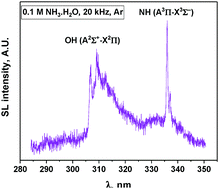当前位置:
X-MOL 学术
›
Phys. Chem. Chem. Phys.
›
论文详情
Our official English website, www.x-mol.net, welcomes your feedback! (Note: you will need to create a separate account there.)
Use of NH (A3Π–X3Σ−) sonoluminescence for diagnostics of nonequilibrium plasma produced by multibubble cavitation
Physical Chemistry Chemical Physics ( IF 3.3 ) Pub Date : 2017-09-05 00:00:00 , DOI: 10.1039/c7cp04813k Rachel Pflieger 1, 2, 3, 4, 5 , Temim Ouerhani 1, 2, 3, 4, 5 , Thierry Belmonte 6, 7, 8, 9 , Sergey I. Nikitenko 1, 2, 3, 4, 5
Physical Chemistry Chemical Physics ( IF 3.3 ) Pub Date : 2017-09-05 00:00:00 , DOI: 10.1039/c7cp04813k Rachel Pflieger 1, 2, 3, 4, 5 , Temim Ouerhani 1, 2, 3, 4, 5 , Thierry Belmonte 6, 7, 8, 9 , Sergey I. Nikitenko 1, 2, 3, 4, 5
Affiliation

|
In this work, the sonoluminescence of NH radicals has been evaluated as a new spectroscopic probe for the nonequilibrium plasma produced by multibubble cavitation in liquids. The experiments were performed in aqueous ammonia solutions subjected to power ultrasound at low and high frequencies and under two different rare gases (Ar and Xe). Sonoluminescence (SL) spectroscopy focuses on the emission of the two present systems: NH (A3Π–X3Σ−) and OH (A2Σ+–X2Π). Both spectroscopic systems indicate the absence of thermal equilibrium during bubble collapse (Tv > Tr) irrespective of the saturating gas. When Ar is used as the saturating gas, these emissions can be fitted using Specair software and the corresponding rovibronic temperatures are derived. Both species indicate a net increase in vibrational temperatures with the US frequency. In Xe, the SL spectra exhibit OH (C2Σ+–A2Σ+) and NH (c1Π–a1Δ) emission bands indicating a higher electron temperature compared to Ar. However, in Xe, the SL spectra cannot be satisfactorily fitted because of significant line broadening. The estimation of the intrabubble pressure via SL simulation using Specair software is discussed. Monitoring of the sonochemical activity indicates the formation of H2 and N2H4, while no H2O2 accumulates under these conditions. In the presence of Xe, NO is also formed as a sonolysis product. The appearance of new possible reaction pathways under Xe is made possible by the higher plasma electron density and correlates with SL data.
中文翻译:

NH(A的使用3 Π-X 3 Σ -用于通过空化multibubble产生非平衡等离子体的诊断声致发光)
在这项工作中,NH自由基的声致发光已被评估为一种新的光谱探针,用于探测液体中多气泡空化产生的非平衡等离子体。实验是在氨水溶液中进行低频和高频超声,并在两种不同的稀有气体(氩气和氙气)下进行的。声致发光(SL)光谱集中于两个本发明的系统的排放:NH(A 3 Π-X 3 Σ - )和OH(A 2 Σ + -X 2 Π)。两种光谱系统均表明在气泡破裂期间不存在热平衡(T v > T r),而不考虑饱和气体。当将Ar用作饱和气体时,可以使用Specair软件拟合这些排放,并推导出相应的转子电子温度。这两个物种都表明振动温度随着美国频率的增加而净增加。在氙中,SL光谱表现出OH(C 2 Σ + -A 2 Σ +)和NH(C 1 Π-A 1个Δ)发射带指示相比氩更高的电子温度。但是,在Xe中,由于谱线明显变宽,所以SL光谱不能令人满意地拟合。气泡内压力的估计通过讨论了使用Specair软件进行的SL仿真。声化学活性的监测表明H 2和N 2 H 4的形成,而在这些条件下没有H 2 O 2积累。在Xe的存在下,NO也作为声分解产物形成。Xe下新的可能的反应途径的出现通过较高的等离子体电子密度得以实现,并且与SL数据相关。
更新日期:2017-09-21
中文翻译:

NH(A的使用3 Π-X 3 Σ -用于通过空化multibubble产生非平衡等离子体的诊断声致发光)
在这项工作中,NH自由基的声致发光已被评估为一种新的光谱探针,用于探测液体中多气泡空化产生的非平衡等离子体。实验是在氨水溶液中进行低频和高频超声,并在两种不同的稀有气体(氩气和氙气)下进行的。声致发光(SL)光谱集中于两个本发明的系统的排放:NH(A 3 Π-X 3 Σ - )和OH(A 2 Σ + -X 2 Π)。两种光谱系统均表明在气泡破裂期间不存在热平衡(T v > T r),而不考虑饱和气体。当将Ar用作饱和气体时,可以使用Specair软件拟合这些排放,并推导出相应的转子电子温度。这两个物种都表明振动温度随着美国频率的增加而净增加。在氙中,SL光谱表现出OH(C 2 Σ + -A 2 Σ +)和NH(C 1 Π-A 1个Δ)发射带指示相比氩更高的电子温度。但是,在Xe中,由于谱线明显变宽,所以SL光谱不能令人满意地拟合。气泡内压力的估计通过讨论了使用Specair软件进行的SL仿真。声化学活性的监测表明H 2和N 2 H 4的形成,而在这些条件下没有H 2 O 2积累。在Xe的存在下,NO也作为声分解产物形成。Xe下新的可能的反应途径的出现通过较高的等离子体电子密度得以实现,并且与SL数据相关。


























 京公网安备 11010802027423号
京公网安备 11010802027423号